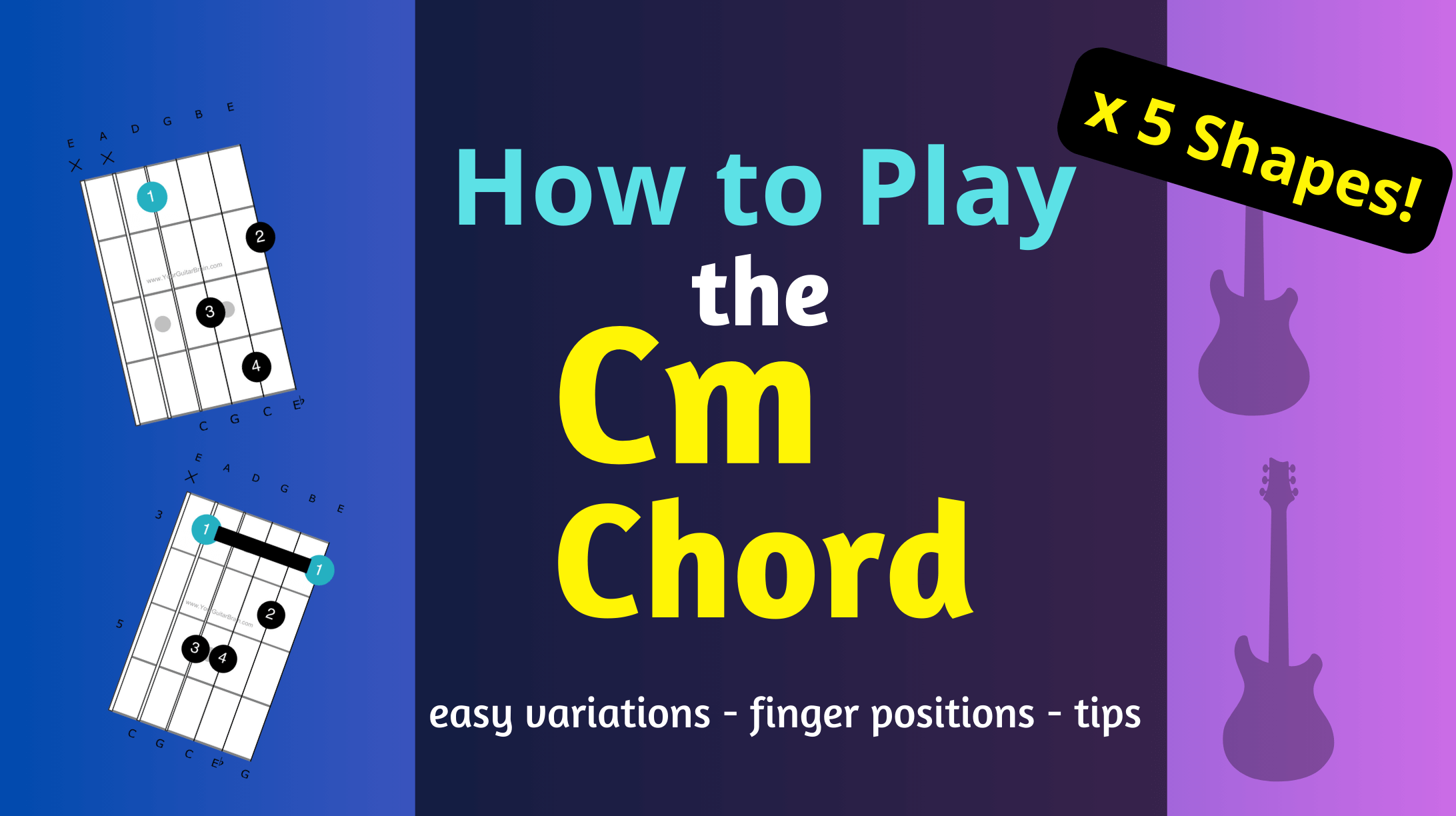Learn the PROPER way to play the C minor guitar chord. We have easy beginner versions to popular barre shapes with large chord charts & killer practice tips to help you improve fast. Let’s dive in!
In this article, you’re going to learn how to play the Cm chord on the guitar. We’ve got a bunch of variations lined up for you to try out.
Whether you’re a guitar beginner or a seasoned strummer, there’s something here for everyone.
From simple open chords to the proper barre C minor barre chord shapes (and tips on the best way to get them sounding clean and clear), you’ll find the perfect fit for your skill level.
C Minor Chord Notations
Cm | Cmin | C minor
Cm Chord Sound
The C minor chord has a melancholic sound when strummed on the guitar. You don’t hear Cm used as much in pop songs as some other minor chords (e.g., E minor, A minor, and B minor) because it’s not in the five most commonly used key signatures: C, G, D, A, and E major.
The deal is those five major key signatures are like the go-to for making catchy tunes that get stuck in your head.
Even though C minor isn’t as popular in mainstream songs, you can guarantee it will pop up at some point in your guitar-playing journey.
Like all minor chord types, the C minor chord adds a touch of depth and emotion when it makes an appearance.
Let’s get to the chord charts, shall we?
Cm Chord Theory Facts x 5
- The C minor chord contains the notes C – Eb – G. These notes are found all over the guitar fretboard, which allows you to play Cm using various shapes and voicings up and down the neck.
- The C minor chord is the relative minor of the Eb Major chord. This means the C minor chord is found in the relative key signatures of C minor and Eb Major. (Check out this guide for more help understanding basic music theory.)
The Cm chord interval formula is 1 – b3 – 5.
- The intervals of a C minor chord, like all minor triads, are root > minor third > Major third.
- The C minor chord is often used in the following sequences:
- ii – V – I Progression in Bb Major: Cm – F – Bb
- i – iv – VII Progression in C minor: Cm – Fm – Bb
- i – VI – III – VII Progression in C minor: Cm – Ab – Eb – Bb
- i – iv – v Progression in C minor: Cm – Fm – Gm
Good to Know
I show the best fingerings in the finger position circles in the chord charts below. The chord notes are shown below the boxes with the C root highlighted in blue.
Shape 1 – The Easy Cm Shape
This first Cm chord shape is all about simplicity. No need to worry about barre chords here. It’s perfect for beginners, and even if you’re more experienced, it’s a great complementary C minor guitar chord to play over a fuller cm barre when you’re jamming or recording in your home studio setup.
Heads up: because this chord voicing only contains three notes, it won’t sound as rich and full as the other Cm chord variations on this page. That being said, check out this easy beginner 3-finger Cm shape below. 👇
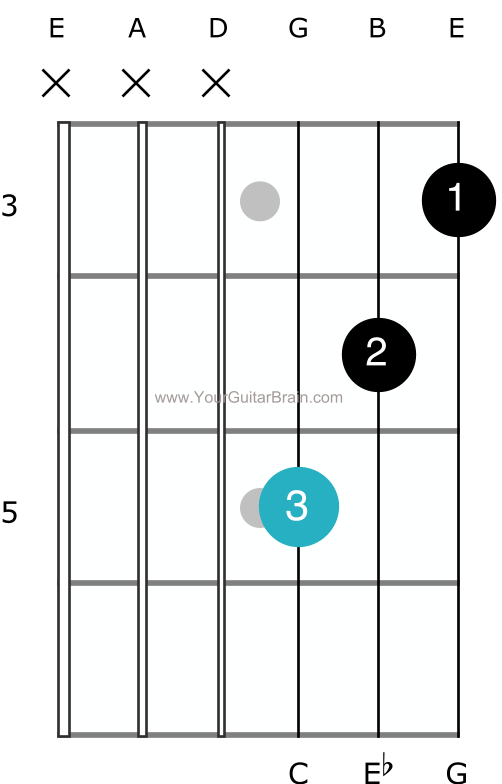
Open Cm chord shape with 3 fingers
Here are the finger positions:
- First (index) finger – 3rd fret of the top E (1st) string
- Second (middle) finger – 4th fret of the B (2nd) string
- Third (ring) finger – 5th fret of the G (3rd) string
Play strings 3-1, and don’t include the bottom 3 strings for this shape.
🎸👉 Practice Tip: To start, set a timer for 60 seconds and metronome to a steady tempo of 70bpm. Then, carefully pick through each individual note of the chord, ensuring that every note sounds clear and crisp.
Repeat these 6o-second reps for a minimum of 7 sets as a great quick practice session warm-up.
Next, add a practice variation of switching between two chords, such as Cm to Gm (the V chord in the key of C minor, so they sound mint together), for smooth playing.
With practice, you’ll soon be strumming away like a pro!
Shape 2 – The 4-Fingered Cm Chord Shape
This 4-finger Cm chord might require one extra finger compared to the previous easy version, but it unlocks a fuller sound.
Think of it as adding some extra flavor to your music without going full-blown barre chord. Ready to try this Cm chord shape and add some depth to your playing? Let’s take a look.👇
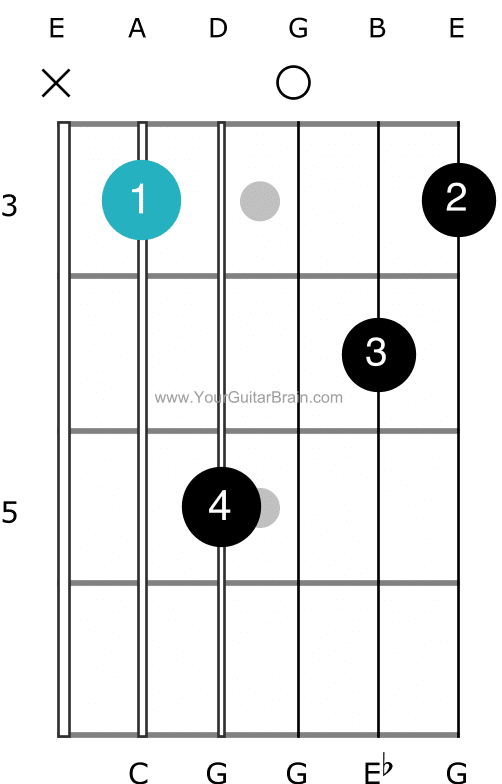
Open Cm chord shape with 4 fingers
Here are the finger positions:
- First (index) finger – 3rd fret of the A (5th) string
- Second (middle) finger – 3rd fret of the top E string
- Third (ring) finger – 4th fret of the B (2nd) string
- Fourth (pinky) finger – 5th fret of the D (4th) string
In this Cm shape, you mute the low E string and include the rest for a nice open sound.
Shape 3 – Cm Chord: The D Shape
This next Cm chord might sound fancy, and it also uses a clever trick! Have you mastered the open Dm chord (the one without barring any frets)?
Great! This Cm chord takes that shape and slides it up the neck.
Here’s why it works:
- The CAGED System: CAGED is a way of understanding how chords are built across the fretboard. It uses familiar open chord shapes (e.g., D Major and D minor) as “templates” that can be moved to different parts of the neck to create new chords.
- Moving the Dm shape: When you move the open Dm chord shape up the neck you’re essentially playing the same intervals on the fretboard, but in a different key.
- Mind the open string: When you shift the Dm chord shape up to create the Cm chord, you have to adjust for the open string (root note location) that was used in the original Dm shape.
👉 Since there’s no open string in the Cm chord, you’ll need to use your first finger to fret the root note on fret 10. This ensures that all the chord intervals remain the same as you move from the Dm to the Cm chord shape.
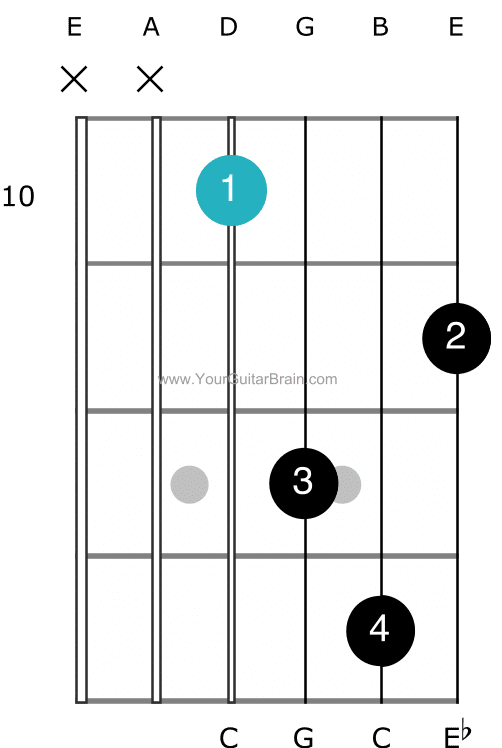
Cm guitar chord Dm CAGED shape
Finger placements:
- First (index) finger – 10th fret of the D string.
- Second (middle) finger – 11th fret of the top E string.
- Third (ring) finger – 12th fret of the G string.
- Pinky (fourth) – 13th fret of the B string.
🎸👉 Practice Tip: Don’t rush! Start by picking each note of the chord individually, focusing on a clear and mute-free sound for each one.
Gradually increase the picking speed as your finger independence and strength improve. Aim for a metronome set to a slow tempo at first, and gradually increase the speed as you become more comfortable.
Shape 4 – Cm Chord: The A Shape
Feeling ready to graduate to barre chords? This Cm version uses the familiar movable CAGED system Am shape.
You need to barre across strings 5-1 on the 3rd fret with the root note on the A string.
Don’t be discouraged if barre chords feel tricky at first. You should first master the 7 most important open guitar chords before attempting barre chords.
Psst… If you’re unsure what the CAGED system is, it’s time to brush up on your basic music theory.
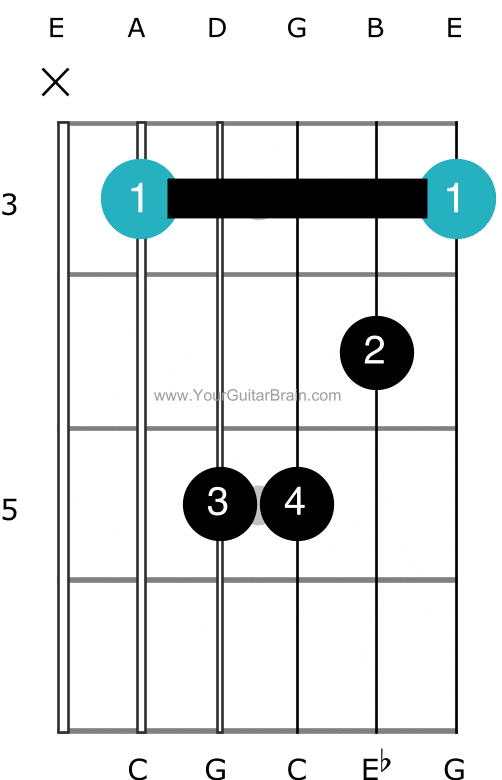
C minor barre chord chart (Am CAGED shape)
The C root note is found on the 3rd fret of the A string. Read the instructions below for where to place your digits.
- First (index) finger – 3rd fret of the A (5th) string & barre across all five strings (5-1)
- Second (middle) finger – 4th fret of the B (2nd) string
- Third (ring) finger – 5th fret of the D (4th) string
- Pinky (fourth) finger – 5th fret of the G (3rd) string
🎸👉 Practice Tip: Before diving into barre chords, make sure you can play open chords cleanly and effortlessly. If your open chords are sketchy and you try barre chords too soon, it’ll only lead to frustration when tackling barre versions. Master the basics first, then build on them, superstar style.
Useful Related Posts
👉 The 7 Chords Every Guitar Player Should Know
👉 How to Play the B minor Chord on Guitar
👉 How to Play Along to Songs on Guitar (6 Tips That 100% Work)
Shape 5 – Cm Chord: The E Shape
This next Cm chord shape is a great workout for your barre strength and finger independence. It uses the CAGED Em shape with a barre at the 8th fret, creating a higher-pitched Cm chord.
This position stretches your fingers further compared to lower barre placements, requiring good control and coordination.
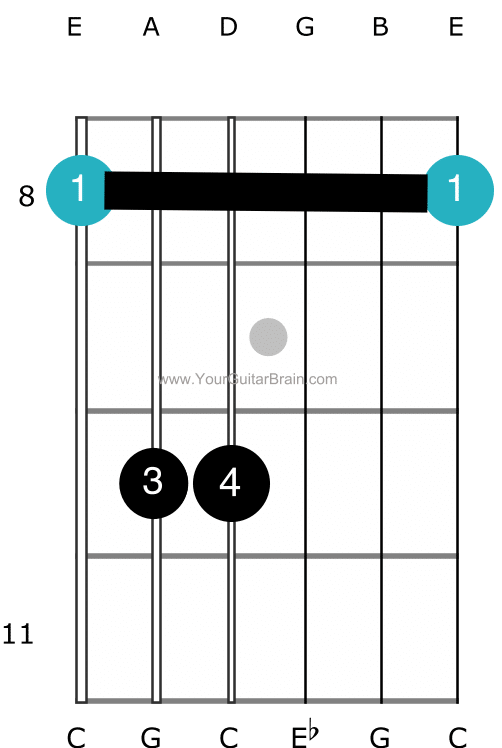
Cm Chord – “E Shape”
The C root note is on the 8th fret of the low E string. Songwriters use the Cm chord to evoke a range of emotions from sadness to nostalgia to heartbreak, as with all minor chords.
Here are the finger positions:
- First (index) finger – 8th fret of the low E string and barre across all six strings (6-1)
- Third (ring) finger – 10th fret of the A string
- Pinky (fourth) finger – 10th fret of the D string
Cm Chord Practice Tips
The following tips will not only improve how the Cm chord sounds on your guitar, but can also be applied to other chords you’re learning. Win-win!
As with any new chord, practice is key. Take your time to get comfortable with the finger placements and practice daily to make a lasting difference.
And don’t be afraid to experiment by adding one or two new shapes to your repertoire—that’s how you’ll discover your unique sound.
Tip #1. Thumb Placement
Struggling with those Cm barre chord shapes? Let’s start by adjusting your thumb position. Aim to place your thumb in the middle of the back of the guitar neck, aligning it with where your second finger is/would be on the fretboard.
For instance, if you’re playing the Am shape Cm chord (root note on fret 3), position your thumb beneath fret 4.
When you keep your thumb in this optimum position it makes it easier to stretch your fingers and achieve a clean chord sound.
Tip #2. Barre Chord Trick
Finding it tough to keep your index finger flat while playing a barred C minor chord? No worries, it happens to the best of us. Instead of getting cheesed off, try a simple trick.
Release your finger from the fretboard and then place it back down. When it fatigues or slides out of position again, release and replace.
This little reset can help alleviate any tension and gradually strengthen your finger muscles. Just remember, progress takes time, so be patient with yourself and keep practicing.
Tip #3. One at a Time
The Cm barre chord voicings can feel like a finger stretch, especially for beginners. Instead of tackling the whole chord at once, break it down finger by finger.
Hold down each finger individually on its designated fret, pick the note, and make sure it rings clearly. Once each finger feels comfortable on its own, slowly work your way through placing all fingers together, focusing on a clean sound.
Check this out
Heads up! Do you need to buy a few more things to go with you guitar? Check this out to make sure you're 100% prepared: op 15 Must Have Guitar Accessories & Gear
Cm Chord FAQs
1. What’s the difference between a Cm and C major chord?
So, you’ve stumbled upon the Cm and C Major chords and you’re wondering, what’s the deal? Well, let’s break it down in simple terms.
C minor (Cm): This chord is the moody cousin of C Major. It has a darker, more emotional vibe. When you play Cm, you add a twist of melancholy to your music.
C major: The classic C Major chord is like a ray of sunshine on a cloudy day. It’s bright, it’s happy, and it’s a staple in countless songs across different genres.
So, the main difference? It all comes down to the third note of the chord. In C minor, that third note is lowered (minor third), giving it that signature somber sound. In C major, it stays nice and bright (major third).
2. Is C minor a tough chord for beginners?
It might take some practice, but beginners can definitely conquer the Cm chord with a bit of perseverance. Start with simpler variations and work your way up as you build confidence.
3. Is the C minor chord common in popular music?
The C minor chord is fairly common in songs but not as common as its other minor brothers and sisters, such as E minor, A minor, and B minor.
Like all minor chords, the Cm chord can transform a happy song into a more contemplative or melancholic mood. It’s like when the weather changes from sunny to cloudy, and you feel that change in the air.
In Summary
So, the Cm chord might seem like a finger-twisting challenge at first, especially with all those barre shapes. But don’t fret (pun intended)!
Here’s the bottom line:
- Start simple: There are plenty of Cm voicings that don’t require a full barre, and we covered three of them in this article. Explore these open chords or the movable shapes based on the CAGED system to build up finger strength ready for the full barre commitment.
- Practice makes perfect: Barre chords take time and dedication. Don’t get discouraged if you don’t master them overnight. Focus on consistent practice using the tips mentioned earlier, and you’ll soon be barring clean Cm chords.
- The journey is fun: Learning guitar is a journey, not a stressy scramble for the finish line. Enjoy the process of improving your Cm chords, and celebrate your progress along the way.
Now go out there and make some schweet music!

